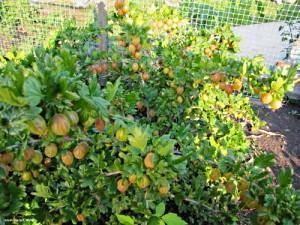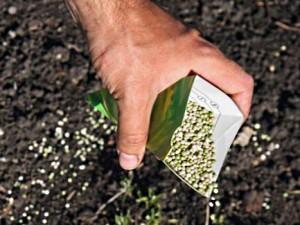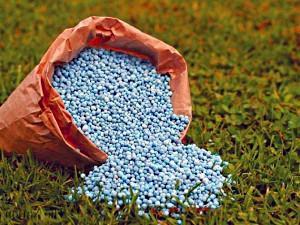What fertilizer to use for gooseberry?
 Many gooseberry growers know that to get a good harvest with large, fragrant and sweet berries, it is necessary to apply the right gooseberry fertilizer.
Many gooseberry growers know that to get a good harvest with large, fragrant and sweet berries, it is necessary to apply the right gooseberry fertilizer.
Gooseberry is not a very whimsical shrub, but it still requires proper care and timely fertilization. If you give him everything he needs, then he is able to bear fruit for several decades, giving 8-10 kg of berries from one bush.
It is necessary to start feeding gooseberries in the first year after planting. This promotes the formation of strong branched bushes with a significant number of young basal shoots. The plant reaches good yields in 5-7 years.
Fertilizing Gooseberry Tips
To obtain high yields, it is necessary to fertilize the soil well, because, depending on the increase in the number of berries, the need for necessary nutrients also increases. Gooseberry roots go deep into the ground by about 1.5 meters, but most of them are located at a depth of no more than 35 cm. The best soil for a shrub is light, loose soil (sandy is best). Therefore, it is very important to make the soil loose.
 The soil is especially depleted and lacking in nutrients (especially nitrogen) in early spring. During this period, the plant is especially active: buds and flowers begin to bloom, so you need to worry about fertilizing the soil. How to fertilize gooseberries in spring? Particularly relevant during this period will be nitrogen fertilizers
The soil is especially depleted and lacking in nutrients (especially nitrogen) in early spring. During this period, the plant is especially active: buds and flowers begin to bloom, so you need to worry about fertilizing the soil. How to fertilize gooseberries in spring? Particularly relevant during this period will be nitrogen fertilizers
In the last month of spring and summer, the gooseberry also needs feeding, which helps in filling the berries and laying new fruit buds. If the leaves and ovaries on the bush fall off very early, then this indicates a lack of nutrients. Most experts recommend a fertilizer that contains chlorine. This type of fertilizer is introduced in the fall. Nitrogen fertilizer (nitrate form of nitrogen) is applied in early spring.
Summer residents recommend three main ways to improve the soil for planting gooseberries:
- Periodic fertilization of the planned soil over two or three years.
- One-time soil fertilization, produced by ring circles.
- Annual feeding, in which the depth of soil cultivation around the bush gradually decreases.
How to fertilize gooseberries?
 Many novice gardeners are interested in the question of how to fertilize gooseberries. During the first year after planting, starting during flowering and fruiting, saltpeter will be a very useful fertilizer. For one bush, you need to prepare about 250 g of this nutrient, dividing it into three doses. The first time the bush is fed if the length of the shoots has reached 5-6 cm. The next two dressings are carried out at equal intervals of 2-3 weeks.
Many novice gardeners are interested in the question of how to fertilize gooseberries. During the first year after planting, starting during flowering and fruiting, saltpeter will be a very useful fertilizer. For one bush, you need to prepare about 250 g of this nutrient, dividing it into three doses. The first time the bush is fed if the length of the shoots has reached 5-6 cm. The next two dressings are carried out at equal intervals of 2-3 weeks.
If we talk about a 2-3-year-old plant, then the amount saltpeter increases to 300 g per bush (2-3 handfuls). Half of the fertilizer is applied in early spring and half in May.
 If during the planting of the gooseberry, phosphorus and potash fertilizers, then it is during this period that it is necessary to feed them (100 g of potassium salt and superphosphate under one bush). Fertilizers must be evenly scattered around the bush, no closer than 0.5 meters and no further than a meter from the base.
If during the planting of the gooseberry, phosphorus and potash fertilizers, then it is during this period that it is necessary to feed them (100 g of potassium salt and superphosphate under one bush). Fertilizers must be evenly scattered around the bush, no closer than 0.5 meters and no further than a meter from the base.
From the fourth year of the life of the bush, nitrogen, potash and phosphorus fertilizers should be applied annually.
 To feed the gooseberry, nitrogen fertilizers are widely used in the form of ammonium nitrate (60 g per one bush) or urea (40-45 g per bush). If we talk about phosphate fertilizers, then double superphosphate (50-60 g per bush) is best suited for gooseberries. But it should be remembered that if the soil is acidic, then instead of superphosphate, it is necessary to use supertomasin or thermophosphate.
To feed the gooseberry, nitrogen fertilizers are widely used in the form of ammonium nitrate (60 g per one bush) or urea (40-45 g per bush). If we talk about phosphate fertilizers, then double superphosphate (50-60 g per bush) is best suited for gooseberries. But it should be remembered that if the soil is acidic, then instead of superphosphate, it is necessary to use supertomasin or thermophosphate.
Potash fertilizers for gooseberries are represented by potassium sulfate (50-80 g per bush) and wood ash (300-400 g per bush). You can also use high-percentage potassium salts (100 g per bush).
If the gooseberry yields very large yields and grows poorly, then after picking the berries, it is necessary to additionally add saltpeter (200 kg per 1 ha).
 Organic fertilizers have a positive effect on the growth and fruiting of gooseberries. Since most of the roots are not deep, it will be appropriate to apply humus. Therefore, in order to obtain a good harvest of gooseberries, it is necessary to make a stock of manure. On small backyards, compost can also be used instead of manure.
Organic fertilizers have a positive effect on the growth and fruiting of gooseberries. Since most of the roots are not deep, it will be appropriate to apply humus. Therefore, in order to obtain a good harvest of gooseberries, it is necessary to make a stock of manure. On small backyards, compost can also be used instead of manure.
Manure should be applied every two years. One hectare will need 200 centners, based on this, 10-15 kg is enough for one bush. It must be evenly distributed over the entire area with gooseberries, you can dig it up, or you can leave it on the surface and use it as mulch. Manure as fertilizer introduced into the soil in the fall. If there is no manure, then even potato tops may work well. Phosphorus and potash fertilizers can be spread before spreading manure.
 On highly depleted soils, gooseberries can be fed with liquid organic fertilizers. This procedure must be carried out 2 times, the first - after flowering, the second - after picking the berries. Such fertilizers are diluted with water in the following proportions before applying to the soil:
On highly depleted soils, gooseberries can be fed with liquid organic fertilizers. This procedure must be carried out 2 times, the first - after flowering, the second - after picking the berries. Such fertilizers are diluted with water in the following proportions before applying to the soil:
- Slurry - 1/7,
- Mullein - 1/5,
- Bird droppings - 1/12.
For each gooseberry bush such a solution, you must use 10 liters. It is introduced into the previously dug grooves on both sides of the bush.
If you follow all the recommendations on the use of fertilizers for feeding gooseberries, then the plant will be less susceptible to diseases and pests, as well as delight with good and high-quality crops for many years.
Secrets of growing gooseberries - video